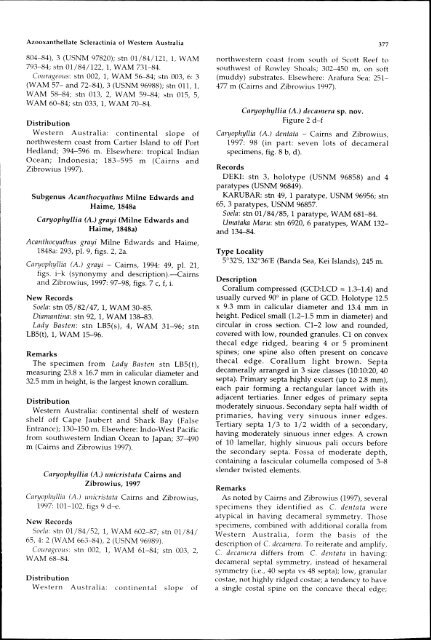Azooxanthellate Scleractinia (Cnidaria: Anthozoa) - Western ...
Azooxanthellate Scleractinia (Cnidaria: Anthozoa) - Western ...
Azooxanthellate Scleractinia (Cnidaria: Anthozoa) - Western ...
Create successful ePaper yourself
Turn your PDF publications into a flip-book with our unique Google optimized e-Paper software.
------------------------------------------------..<br />
<strong>Azooxanthellate</strong> <strong>Scleractinia</strong> of <strong>Western</strong> Australia<br />
804-84),3 (USNM 97820); stn 01/84/121, 1, WAM<br />
793-84; stn 01/84/122,1, WAM 731-84.<br />
Courageous: stn 002, 1, WAM 56-84; stn 003, 6: 3<br />
(WAM 57- and 72-84), 3 (USNM 96988); stn 011, 1,<br />
WAM 58-84; stn 013, 2, WAM 59-84; stn 015, 5,<br />
WAM 60-84; stn 033, 1, WAM 70-84.<br />
Distribution<br />
<strong>Western</strong> Australia: continental slope of<br />
northwestern coast from Cartier Island to off Port<br />
Hedland; 394-596 m. Elsewhere: tropical Indian<br />
Ocean; Indonesia; 183-595 m (Cairns and<br />
Zibrowius 1997).<br />
Subgenus Acanthocyathus Milne Edwards and<br />
Haime, 1848a<br />
Caryophyllia (A.) grayi (MiIne Edwards and<br />
Haime, 1848a)<br />
Acanthocyathus grayi Milne Edwards and Haime,<br />
1848a: 293, pI. 9, figs. 2, 2a.<br />
Caryophyllia (A) grayi - Cairns, 1994: 49, pI. 21,<br />
figs. i-k (synonymy and description).-Cairns<br />
and Zibrowius, 1997: 97-98, figs. 7 c, f, i.<br />
New Records<br />
Soela: stn 05/82/47, 1, WAM 30-85.<br />
Diamantina: stn 92, 1, WAM 138-83.<br />
Lady Basten: stn LB5(s), 4, WAM 31-96; stn<br />
LB5(t), 1, WAM 15-96.<br />
Remarks<br />
The specimen from Lady Basten stn LB5(t),<br />
measuring 23.8 x 16.7 mm in calicular diameter and<br />
32.5 mm in height, is the largest known corallum.<br />
Distribution<br />
<strong>Western</strong> Australia: continental shelf of western<br />
shelf off Cape Jaubert and Shark Bay (False<br />
Entrance); 130-150 m. Elsewhere: Indo-West Pacific<br />
from southwestern Indian Ocean to Japan; 37--490<br />
m (Cairns and Zibrowius 1997).<br />
Caryophyllia (A.) unicristata Cairns and<br />
Zibrowius,1997<br />
Caryophyllia (A) ll11icristata Cairns and Zibrowius,<br />
1997: 101-102, figs 9 d--e.<br />
New Records<br />
Soela: stn 01/84/52,1, WAM 602-87; stn 01/84/<br />
65,4: 2 (WAM 663-84), 2 (USNM 96989).<br />
Courageous: stn 002, 1, WAM 61-84; stn 003, 2,<br />
WAM 68-84.<br />
Distribution<br />
<strong>Western</strong> Australia: continental slope of<br />
377<br />
northwestern coast from south of Scott Reef to<br />
southwest of Rowley Shoals; 302--450 m, on soft<br />
(muddy) substrates. Elsewhere: Arafura Sea; 251<br />
477 m (Cairns and Zibrowius 1997).<br />
Caryophyllia (A.) decamera sp. novo<br />
Figure 2 d-f<br />
Caryophyllia (A) dentata - Cairns and Zibrowius,<br />
1997: 98 (in part: seven lots of decameral<br />
specimens, fig. 8 b, d).<br />
Records<br />
DEKI: stn 3, holotype (USNM 96858) and 4<br />
paratypes (USNM 96849).<br />
KARUBAR: stn 49, 1 paratype, USNM 96956; stn<br />
65, 3 paratypes, USNM 96857.<br />
Soela: stn 01/84/85,1 paratype, WAM 681-84.<br />
Umataka Maru: stn 6920, 6 paratypes, WAM 132and<br />
134-84.<br />
Type Locality<br />
5°32'S, 132°36'E (Banda Sea, Kei Islands), 245 m.<br />
Description<br />
Corallum compressed (GCD:LCD = 1.3-1.4) and<br />
usually curved 90° in plane of GCD. Holotype 12.5<br />
x 9.3 mm in calicular diameter and 13.4 mm in<br />
height. Pedicel small (1.2-1.5 mm in diameter) and<br />
circular in cross section. Cl-2 low and rounded,<br />
covered with low, rounded granules. CIon convex<br />
thecal edge ridged, bearing 4 or 5 prominent<br />
spines; one spine also often present on concave<br />
thecal edge. Corallum light brown. Septa<br />
decamerally arranged in 3 size classes (10:10:20, 40<br />
septal· Primary septa highly exsert (up to 2.8 mm),<br />
each pair forming a rectangular lancet with its<br />
adjacent tertiaries. Inner edges of primary septa<br />
moderately sinuous. Secondary septa half width of<br />
primaries, having very sinuous inner edges.<br />
Tertiary septa 1/3 to 1/2 width of a secondary,<br />
having moderately sinuous inner edges. A crown<br />
of 10 lamellar, highly sinuous pali occurs before<br />
the secondary septa. Fossa of moderate depth,<br />
containing a fascicular columella composed of 3-8<br />
slender twisted elements.<br />
Remarks<br />
As noted by Cairns and Zibrowius (1997), several<br />
specimens they identified as C. dentata were<br />
atypical in having decameral symmetry. Those<br />
specimens, combined with additional coralla from<br />
<strong>Western</strong> Australia, form the basis of the<br />
description of C. decamera. To reiterate and amplify,<br />
C. decamera differs from C. dentata in having:<br />
decameral septal symmetry, instead of hexameral<br />
symmetry (i.e., 40 septa vs 48 septal; low, granular<br />
costae, not highly ridged costae; a tendency to have<br />
a single costal spine on the concave thecal edge;
















